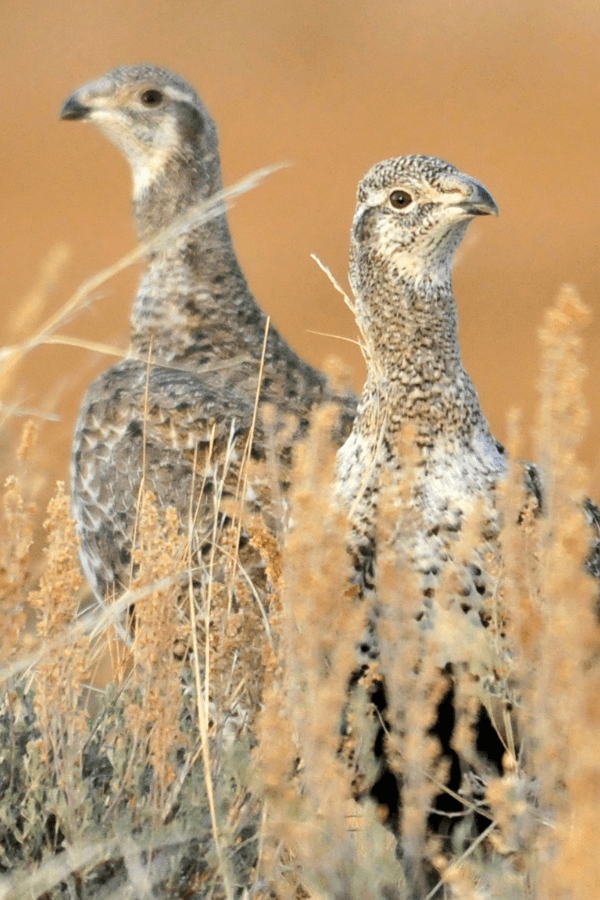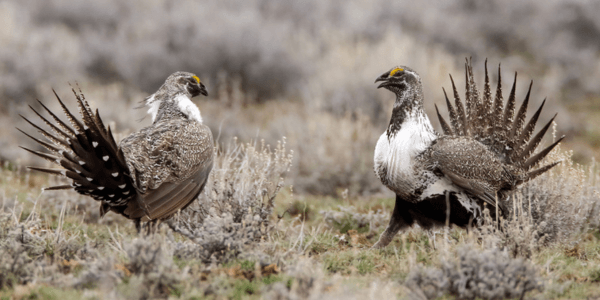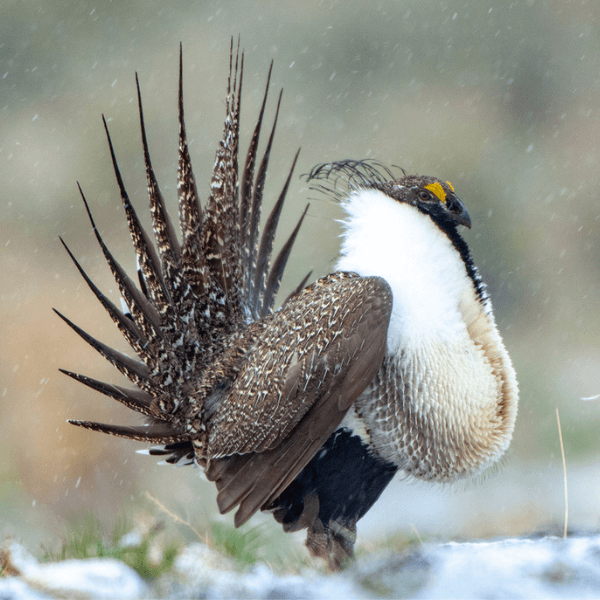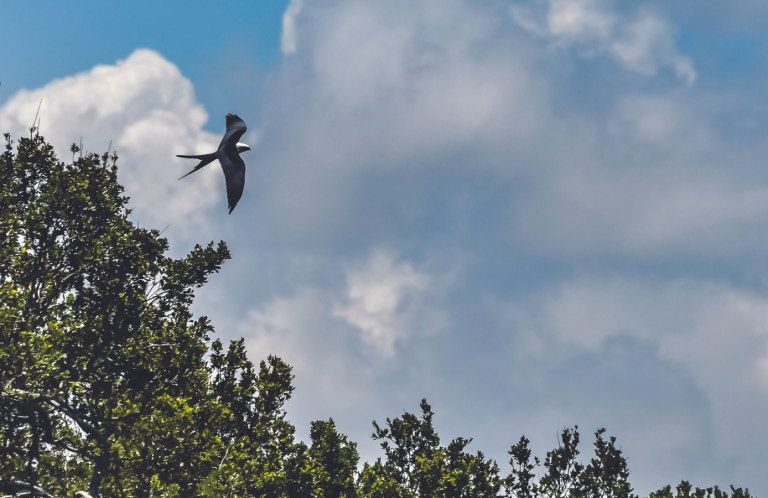Preventing a Greater Sage-Grouse Vanishing Act

The future of the Greater Sage-Grouse, an iconic species of the American West, is in doubt. For decades its numbers have dwindled as its unique habitat, the sagebrush steppe, shrinks. Now, American Bird Conservancy (ABC) and partners are fighting for what might be the species' last hope for a chance at survival.
ABC is calling on supporters to participate in an open comment period designed to gather feedback on a new set of management plans proposed by the Bureau of Land Management (BLM). ABC and other conservation groups are championing Alternative 3 and the designation of Areas of Critical Environmental Concern (ACEC) to provide more durable, comprehensive protections for the habitat most vital to the Greater Sage-Grouse. In the lead-up to the proposals from the BLM, ABC and other conservation groups nominated all priority grouse habitat — 34 million acres — for consideration for ACEC designation. Only 11 million acres were reviewed, and no ACECs were written into the BLM's preferred plan.
“The preferred alternative proposed by the Bureau of Land Management doesn't go nearly far enough in ensuring the habitat the Greater Sage-Grouse needs is conserved,” said Steve Holmer, Vice President of Policy at ABC. “The science shows that the grouse will continue to experience the steep declines that have already had a devastating impact on the species.”

The population of Greater Sage-Grouse — some 150,000 individuals, teetering on the edge of remaining biologically sustainable — is found almost entirely on federal land managed by the BLM. ACECs are designated areas within BLM-managed lands that require special care and management, often due to the presence of a fragile ecosystem, an imperiled plant or animal species, or to protect sites of historic, religious, or cultural significance. Strategically designating ACECs in the most vital grouse habitat would bring the land and the birds on it under stricter, long-lasting protections.
The plan put forward by the BLM is part of the process of updating the previously approved Greater Sage-Grouse management plans dating back to 2015. The Bureau's preferred alternative would apply to 69 million acres across 10 states, but without the designation of ACECs, it lacks adequate protections and would continue a tradition of grouse management plans creating loopholes for oil and gas drilling, and mining.
“The BLM's preferred plan is unlikely to succeed in reversing the trend of grouse habitat shrinking and is unlikely to prevent extinction,” said Holmer. “We need a new strategy, and a range-wide network of Areas of Critical Environmental Concern is our best hope for the species. The absence of ACECs from the BLM's plan is deeply concerning.”
Comprehensive, connected habitat is essential for the Greater Sage-Grouse. Its use of the sagebrush steppe changes seasonally. In early spring, clearings with low grasses provide a perfect stage for lekking in the breeding season; these sites become important for the social fabric of grouse and are often used year after year. Females show strong fidelity to their nesting sites tucked away under the cover of big sagebrush, returning each year to raise young before they disperse to meadows, alfalfa fields, and other areas in the steppe. The sagebrush steppe, sometimes called the sagebrush sea, is the only habitat the Greater Sage-Grouse knows and the only place it can survive.
An Imperiled Bird's Unlikely Showmanship
At first glance, the Greater Sage-Grouse looks fairly unremarkable: females are a dull, speckled brown and gray that blends in with the dusty ground. They are round and have a heavy, gravity-laden appearance to them. The males sport a thick layer of white feathers on their chest that only adds to the effect, making them appear top-heavy. The Greater Sage-Grouse looks a good deal like a big, brown chicken with a halting, awkward gait. Nothing about the grouse suggests its incredible showmanship and star power.
Their stage is the communal lek, where these drab birds transform and put on one of the most outstanding courtship displays of any North American species, bird or otherwise. It is a scene that is both bizarre and profoundly moving. Females gather to watch a performance as males puff out their chests and begin to strut. Their sharp tail feathers jut out almost menacingly as they parade about, stomping and sparring. With a deep inhale, their yellow throat sacs inflate and emerge from the surrounding layer of white feathers, making a surprisingly loud “pop!” as they rise upward against gravity. The sounds of their throats ballooning and booming resonate across the grassy plains. Yes, the Greater Sage-Grouse is a big, chicken-like bird. But everything about it in this moment is captivating, its display suggesting something primordial and enduring, almost like an elaborate, even magical ritual.
These complex social dynamics are part of what makes them so sensitive to disturbances. Leks and nesting sites have been abandoned and have collapsed as oil and gas drilling operations have encroached on them. Curbing the level of disturbance near the grouse is one strategy for protecting them. Caps are set to determine the amount of anthropogenic (human-caused) disturbances like development, drilling, and other activities the birds can tolerate across a given percentage of their habitat. Ongoing monitoring shows that nearly all of the remaining priority grouse populations currently exist in areas with less than 1 percent disturbance, and still, the species is struggling. The BLM plan maintains disturbance caps at 3-5 percent and decreases the size of the buffer zone required between development and important grouse habitat from 3 miles to 0.6 miles.
“At that level of disturbance,” Holmer said, “we would expect to eventually see no grouse.”
A Barometer for the Health of a Vulnerable Habitat
In many ways, the Greater Sage-Grouse mirrors the sagebrush sea it inhabits: on the surface, both look unremarkable, a brown bird on a dry, colorless steppe. The landscape of gently rolling plains carpeted with scraggly, gray-green shrubs looks barren. But, that silvery expanse is as deceptive as the grouse, because it is teeming with life: Pronghorn and Mule Deer lope across the arid steppe. Endangered Pygmy Rabbits, North America's smallest rabbit species, shelter in tangles of sagebrush branches and burrow into the sandy, loamy soil. Nearly 200 migratory birds and Western birds inhabit the sagebrush sea, including the vulnerable Pinyon Jay, Brewer's Sparrow, Sagebrush Sparrow, and Sage Thrasher.
“The Greater Sage-Grouse is to the Midwest what the California Condor is to the West Coast. They are the Polar Bears of the sagebrush sea. If you can protect them, you are protecting everything else,” said Holmer. “Securing the future of the Greater Sage-Grouse and its habitat is entirely within our grasp if we set up ACECs and suspend oil and gas drilling in these sensitive areas.”

The Greater Sage-Grouse is not only an icon of a unique and storied habitat; it is also an indicator of the habitat's health. For decades, the grouse has been sending out an S.O.S. The bird's population has declined precipitously from an estimated 16 million birds before the American West was colonized to as few as 150,000 individuals today. Loss, fragmentation, and degradation of the sagebrush steppe from development and oil and gas drilling have driven down their numbers and restricted their range. The U.S. Geological Survey (USGS) modeling predicts further range contraction and the continued, steady decline of the grouse under current plans. Fifty years from now, the Greater Sage-Grouse population, if it exists at all, will be significantly diminished.
The Greater Sage-Grouse's story is also a story about energy and climate. The sagebrush steppe has been parceled off bit by bit to accommodate oil and gas drilling, roads, power lines, and now wind and solar arrays. The landscape, once a contiguous gray-green sea spanning millions of acres across several states, is now heavily pockmarked by drilling operations, while simultaneously science warns of the dangers of unrestrained oil and gas drilling in a time of worsening climate change. Data from the BLM show a high rate of approval for permit applications. Permitting is easy and there is little precedent for states or the BLM to deny them to prospective oil and gas operations. Even under the current management plans that purport to offer the species protection, exceptions are granted and permits are issued readily. In the new plan with ACECs, that practice would come to an end.
“These birds are excellent barometers of the impacts of oil and gas in a region that has seen a huge amount of development,” said Holmer. “We need to restore balance by ensuring enough habitat is set aside from drilling for the grouse to recover and thrive.”
The Next Best Thing to the Endangered Species Act
One of the biggest challenges facing the Greater Sage-Grouse is that it is exempted from Endangered Species Act (ESA) protections. Despite being listed as Near Threatened by the International Union for Conservation of Nature (IUCN) and the clear evidence of downward population trends, the U.S. Fish and Wildlife Service is prohibited by Congress from providing warranted protection. In 2014, a moratorium on listing the species went into effect. A subsequent rider to an appropriations bill resulted in weakened BLM management plans and states backing out on promises made to protect the bird.

For decades, the Greater Sage-Grouse has continued to suffer under a series of management plans that deliver few benefits to the bird. In lieu of ESA listing, in 2015 the BLM adopted management plans that mirrored some of the protections that grouse would have had, if the species had been listed. But without the backstop of the ESA, there was no real mechanism in place to require states to abide by those plans. Moreover, the management plans that exist now have been shown to be easily undone: loopholes, exceptions, and carve-outs have rendered them mostly ineffective at protecting grouse.
“The ACEC is the best mechanism to conserve grouse habitat, and we also need to restore the possibility of Endangered Species Act protections for the Greater Sage-Grouse to establish a science-based recovery plan,” said Holmer. “If we can build upon ACEC protections with an ESA listing, emerging threats and continued recovery can also be addressed.”
As the Greater Sage-Grouse continues to wait for Congress to restore the potential for an ESA listing, the species' last, best hope is a plan that provides long-lasting protection and closes the loopholes that have plagued other grouse management plans.
“The effort to protect the Greater Sage-Grouse has undergone round after round of planning followed by controversy, and the BLM's preferred alternative seems destined to continue that cycle,” said Holmer. “Our goal is to see a plan that fits the bird's biology and provides the most durable protection possible.”
Alternative 3 could be that plan. With ACEC designation for the 11 million acres analyzed by the Bureau, the establishment of a Net Conservation Benefit Mitigation Standard, science-based buffer standards, a disturbance cap lowered to 1 percent, and no exceptions for drilling and other development, Alternative 3, conservation groups say, would give the grouse the best chance for population stabilization and eventual recovery.
Act now to conserve the Greater Sage-Grouse! Urge the Bureau of Land Management to adopt the strongest conservation plan needed to recover the bird's declining populations. Take action with ABC »


















































